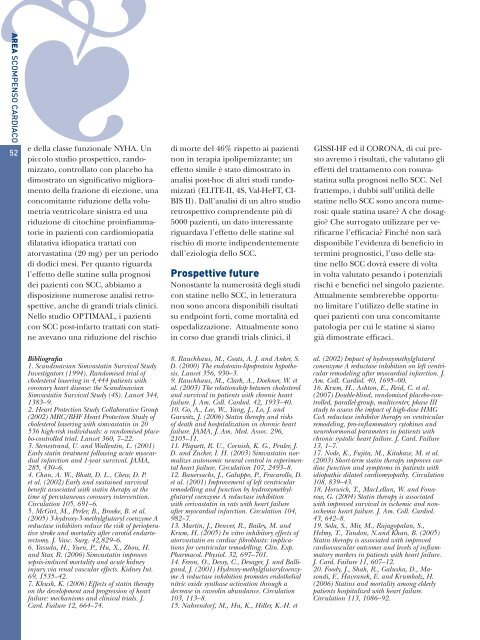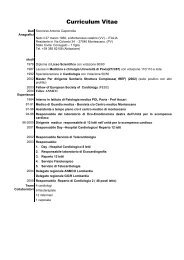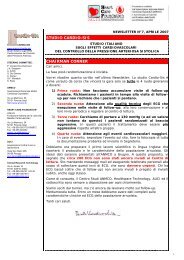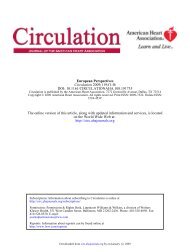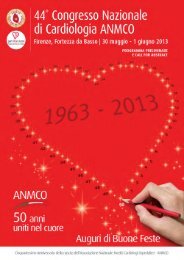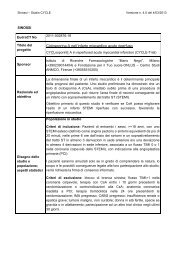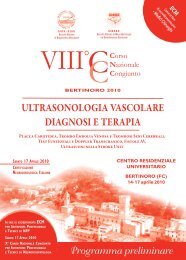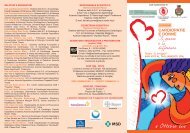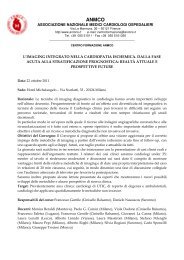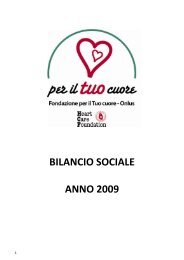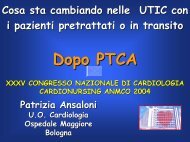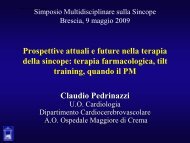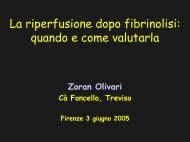Cardiologia negli Ospedali n° 160 Novembre/Dicembre 2007 - Anmco
Cardiologia negli Ospedali n° 160 Novembre/Dicembre 2007 - Anmco
Cardiologia negli Ospedali n° 160 Novembre/Dicembre 2007 - Anmco
Create successful ePaper yourself
Turn your PDF publications into a flip-book with our unique Google optimized e-Paper software.
AREA SCOMPENSO CARDIACO<br />
52<br />
e della classe funzionale NYHA. Un<br />
piccolo studio prospettico, randomizzato,<br />
controllato con placebo ha<br />
dimostrato un significativo miglioramento<br />
della frazione di eiezione, una<br />
concomitante riduzione della volumetria<br />
ventricolare sinistra ed una<br />
riduzione di citochine proinfiammatorie<br />
in pazienti con cardiomiopatia<br />
dilatativa idiopatica trattati con<br />
atorvastatina (20 mg) per un periodo<br />
di dodici mesi. Per quanto riguarda<br />
l’effetto delle statine sulla prognosi<br />
dei pazienti con SCC, abbiamo a<br />
disposizione numerose analisi retrospettive,<br />
anche di grandi trials clinici.<br />
Nello studio OPTIMAAL, i pazienti<br />
con SCC post-infarto trattati con statine<br />
avevano una riduzione del rischio<br />
di morte del 46% rispetto ai pazienti<br />
non in terapia ipolipemizzante; un<br />
effetto simile è stato dimostrato in<br />
analisi post-hoc di altri studi randomizzati<br />
(ELITE-II, 4S, Val-HeFT, CI-<br />
BIS II). Dall’analisi di un altro studio<br />
retrospettivo comprendente più di<br />
5000 pazienti, un dato interessante<br />
riguardava l’effetto delle statine sul<br />
rischio di morte indipendentemente<br />
dall’eziologia dello SCC.<br />
Prospettive future<br />
Nonostante la numerosità degli studi<br />
con statine nello SCC, in letteratura<br />
non sono ancora disponibili risultati<br />
su endpoint forti, come mortalità ed<br />
ospedalizzazione. Attualmente sono<br />
in corso due grandi trials clinici, il<br />
GISSI-HF ed il CORONA, di cui presto<br />
avremo i risultati, che valutano gli<br />
effetti del trattamento con rosuvastatina<br />
sulla prognosi nello SCC. Nel<br />
frattempo, i dubbi sull’utilità delle<br />
statine nello SCC sono ancora numerosi:<br />
quale statina usare? A che dosaggio?<br />
Che surrogato utilizzare per verificarne<br />
l’efficacia? Finché non sarà<br />
disponibile l’evidenza di beneficio in<br />
termini prognostici, l’uso delle statine<br />
nello SCC dovrà essere di volta<br />
in volta valutato pesando i potenziali<br />
rischi e benefici nel singolo paziente.<br />
Attualmente sembrerebbe opportuno<br />
limitare l’utilizzo delle statine in<br />
quei pazienti con una concomitante<br />
patologia per cui le statine si siano<br />
già dimostrate efficaci.<br />
Bibliografia<br />
1. Scandinavian Simvastatin Survival Study<br />
Investigators (1994). Randomised trial of<br />
cholesterol lowering in 4,444 patients with<br />
coronary heart disease: the Scandinavian<br />
Simvastatin Survival Study (4S). Lancet 344,<br />
1383–9.<br />
2. Heart Protection Study Collaborative Group<br />
(2002) MRC/BHF Heart Protection Study of<br />
cholesterol lowering with simvastatin in 20<br />
536 high-risk individuals: a randomised placebo-controlled<br />
trial. Lancet 360, 7–22.<br />
3. Stenestrand, U. and Wallentin, L. (2001)<br />
Early statin treatment following acute myocardial<br />
infarction and 1-year survival. JAMA,<br />
285, 430–6.<br />
4. Chan, A. W., Bhatt, D. L., Chew, D. P.<br />
et al. (2002) Early and sustained survival<br />
benefit associated with statin therapy at the<br />
time of percutaneous coronary intervention.<br />
Circulation 105, 691–6.<br />
5. McGirt, M., Perler, B., Brooke, B. et al.<br />
(2005) 3-hydroxy-3-methylglutaryl coenzyme A<br />
reductase inhibitors reduce the risk of perioperative<br />
stroke and mortality after carotid endarterectomy.<br />
J. Vasc. Surg. 42,829–6.<br />
6. Yasuda, H., Yuen, P., Hu, X., Zhou, H.<br />
and Star, R. (2006) Simvastatin improves<br />
sepsis-induced mortality and acute kidney<br />
injury via renal vascular effects. Kidney Int.<br />
69, 1535–42.<br />
7. Khush, K. (2006) Effects of statin therapy<br />
on the development and progression of heart<br />
failure: mechanisms and clinical trials. J.<br />
Card. Failure 12, 664–74.<br />
8. Rauchhaus, M., Coats, A. J. and Anker, S.<br />
D. (2000) The endotoxin-lipoprotein hypothesis.<br />
Lancet 356, 930–3.<br />
9. Rauchhaus, M., Clark, A., Doehner, W. et<br />
al. (2003) The relationship between cholesterol<br />
and survival in patients with chronic heart<br />
failure. J. Am. Coll. Cardiol. 42, 1933–40.<br />
10. Go, A., Lee, W., Yang, J., Lo, J. and<br />
Gurwitz, J. (2006) Statin therapy and risks<br />
of death and hospitalization in chronic heart<br />
failure. JAMA, J. Am. Med. Assoc. 296,<br />
2105–11.<br />
11. Pliquett, R. U., Cornish, K. G., Peuler, J.<br />
D. and Zucker, I. H. (2003) Simvastatin normalizes<br />
autonomic neural control in experimental<br />
heart failure. Circulation 107, 2493–8.<br />
12. Bauersachs, J., Galuppo, P., Fracarollo, D.<br />
et al. (2001) Improvement of left ventricular<br />
remodelling and function by hydroxymethylglutaryl<br />
coenzyme A reductase inhibition<br />
with cerivastatin in rats with heart failure<br />
after myocardial infarction. Circulation 104,<br />
982–7.<br />
13. Martin, J., Denver, R., Bailey, M. and<br />
Krum, H. (2005) In vitro inhibitory effects of<br />
atorvastatin on cardiac fibroblasts: implications<br />
for ventricular remodelling. Clin. Exp.<br />
Pharmacol. Physiol. 32, 697–701.<br />
14. Feron, O., Dessy, C., Desager, J. and Balligand,<br />
J. (2001) Hydroxy-methylglutarylcoenzyme<br />
A reductase inhibition promotes endothelial<br />
nitric oxide synthase activation through a<br />
decrease in caveolin abundance. Circulation<br />
103, 113–8.<br />
15. Nahrendorf, M., Hu, K., Hiller, K.-H. et<br />
al. (2002) Impact of hydroxymethylglutaryl<br />
conenzyme A reductase inhibition on left ventricular<br />
remodeling after myocardial infarction. J.<br />
Am. Coll. Cardiol. 40, 1695–00.<br />
16. Krum, H., Ashton, E., Reid, C. et al.<br />
(<strong>2007</strong>) Double-blind, randomized placebo-controlled,<br />
parallel-group, multicenter, phase III<br />
study to assess the impact of high-dose HMG<br />
CoA reductase inhibitor therapy on ventricular<br />
remodeling, pro-inflammatory cytokines and<br />
neurohormonal parameters in patients with<br />
chronic systolic heart failure. J. Card. Failure<br />
13, 1–7.<br />
17. Node, K., Fujita, M., Kitakaze, M. et al.<br />
(2003) Short-term statin therapy improves cardiac<br />
function and symptoms in patients with<br />
idiopathic dilated cardiomyopathy. Circulation<br />
108, 839–43.<br />
18. Horwich, T., MacLellan, W. and Fonarow,<br />
G. (2004) Statin therapy is associated<br />
with improved survival in ischemic and nonischemic<br />
heart failure. J. Am. Coll. Cardiol.<br />
43, 642–8.<br />
19. Sola, S., Mir, M., Rajagopalan, S.,<br />
Helmy, T., Tandon, N.and Khan, B. (2005)<br />
Statin therapy is associated with improved<br />
cardiovascular outcomes and levels of inflammatory<br />
markers in patients with heart failure.<br />
J. Card. Failure 11, 607–12.<br />
20. Foody, J., Shah, R., Galusha, D., Masoudi,<br />
F., Havranek, E. and Krumholz, H.<br />
(2006) Statins and mortality among elderly<br />
patients hospitalized with heart failure.<br />
Circulation 113, 1086–92.


